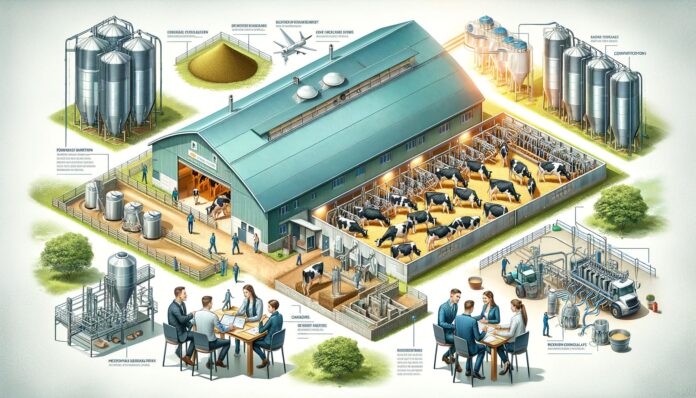Low Productivity of Indian Dairy Animals: Challenges and Mitigation Strategies
Pooja Dixit and Snigdha Shrivastava
In India, dairy is a vital element of agriculture sector and basis of livelihood for small and rural farmers. Currently, India is the world’s largest producer of milk, accounting for 22–24% of global production with the production of 230.58 million tones. The scenario was far different in earlier times, until the revolutionary progress often termed as ‘White Revolution’ was enabled in 1970 by Dr Verghese Kurien which aided technological change in production and improved linkages between production and marketing through a network of dairy cooperatives. This was landmark project of India’s National Dairy Development Board (NDDB) that transformed India from a milk-deficient nation into the world’s largest milk producer.
Challenges
India is blessed with the highest population of dairy animals, but has very poor productivity, which may be due to various factors such as lack of improved breeding and feeding services, access to markets, capital, inputs and technology.
Identification of production constraints was an arduous task. Dairy production is constrained by a number of biotic, abiotic and socioeconomic factors such as breeding, feeding nutrition, health (morbidity and mortality) and some of the critical management problems reduce the production potential of the dairy animals.
Feed scarcity is the predominant constraint for low productivity of Indian dairy animals, and accounts for nearly half of the total losses in dairy production. Lack of availability of green fodder is the most critical nutritional constraint in realizing the production potential of crossbred cows, while mineral deficiency emerges as the most limiting factor in buffaloes and indigenous cows. Inadequate concentrate feeding is the second most important nutritional constraint in improving yields of buffaloes. It is also an important yield-limiting factor in indigenous cows.
Breeding problems are the succeeding constrain, followed by health and management related problems. Repeat breeding, anestrous, failure of artificial insemination and lack of availability of progeny bulls for breeding and are the major breeding problems. Infertility is a major breeding problem in indigenous cows, whereas for buffaloes, the main breeding problem are long-intercalving period, lack of availability of progeny bulls and failure of artificial insemination are important breeding constraints.
In India, rural region is dominated by low yielding indigenous non-descript breeds, which are prone to late calving, infertility, abortion, etc. and are often reared with great sense of negligence and careless attitudes.
Health issues – various diseases lead to severe economic losses to the dairy farmers amongst diseases, foot-and-mouth disease is the most important yield reducing factor in indigenous as well as crossbred cows. Mastitis, black quarter, brucellosis, theilerosis are important diseases in crossbreeds and brucelossis, diarrhoea, pnuemonia, theilerosis and ticks in indigenous cows. In buffalos, mastitis, FMD, ticks, brucelossis, liverflukes and haemorrhagic septicemia are the major diseases.
In majority parts of India, most of the animals are left for free grazing around water bodies and grazing lands and which are grossly infested. These pose a great threat to animal health and make them vulnerable to a number of parasitic diseases.
Poor management- inadequate housing and water scarcity are the main management related problems for all types of dairy animals. Lack of knowledge of seasonal management further reduces their productivity, like summer anoestrus in buffaloes. Farmers also does not maintain proper record of animal like – Health record, vaccination record, calving record, milking record, progeny record etc.
Lack of awareness- farmers are unaware of importance of vaccination and deworming of their animals. Also veterinary aids are less available in far flung areas of the country.
Mitigation Strategies
The Rashtriya Gokul Mission was launched in 2014 as an initiative to develop and conserve the indigenous bovine breeds for improving the milk production and productivity in a scientific manner which includes superior nutrition and farm management.
Mineral deficiency is the most serious problem in all the regions of India for both indigenous cattle and buffaloes, so animals should often kept on better supplementary diets including mineral-vitamin mixtures and concentrates.
Research should be targeted on production and provision of quality bulls and improves effectiveness of artificial insemination to improve yield of dairy animals.
Awareness camp should be organized in different villages to make farmers aware of losses due to different diseases and encouraging them to focus on prevention and control of mastitis, FMD, brucellosis, theileriosis and ticks by vaccinating their animals by various programs held by their state government.
Farmers must be made aware of the various schemes of goverement like – Rashtriya. Gokul Mission, National. Livestock Mission, Livestock Health and disease control, National Programme For Dairy Development etc.
In a comprehensive agricultural initiative, the Finance Minister announces plans for robust dairy development and fisheries expansion in the Budget 2024. The program aims to support dairy farmers, control diseases, and enhance productivity, building on the success of existing schemes.



